MAHA MUDRA – FROM TRADITION TO TRANSFORMATION
Introduction: Before going into the details of Maha Mudra, we should know about Mudra and its importance in Yoga practice. Mudra is a term that means a gesture or a particular mood or feeling of consciousness. It is a sacred gesture of Yoga in Hinduism, Buddhism, and Jainism. It is the way of channeling the flow of vital force or energy, which is known as Prana. The other names of Mudra in English are Gesture, Mark, or Seal. The mudras described in the Yogic scriptures are manifestations of unique moods or feelings of consciousness. This unique technique is known to very few Sadhakas or Practitioners.
Various Mudras are commonly used by various Indian Dancers. Different Mudras or Gestures are used to depict a particular mood or feeling, such as anger, anger is depicted through the eyes. It has been observed that if a particular Mudra is practiced for a longer period, a feeling is created by that Mudra. This concept becomes even more evident in advanced Yoga Practices like Maha Mudra, where gesture is not just symbolic but a profound technique to awaken a deeper state of awareness. It has also been observed in our daily lives. When a person becomes angry, he raises his eyebrows and tenses his hands and clenches his fists.
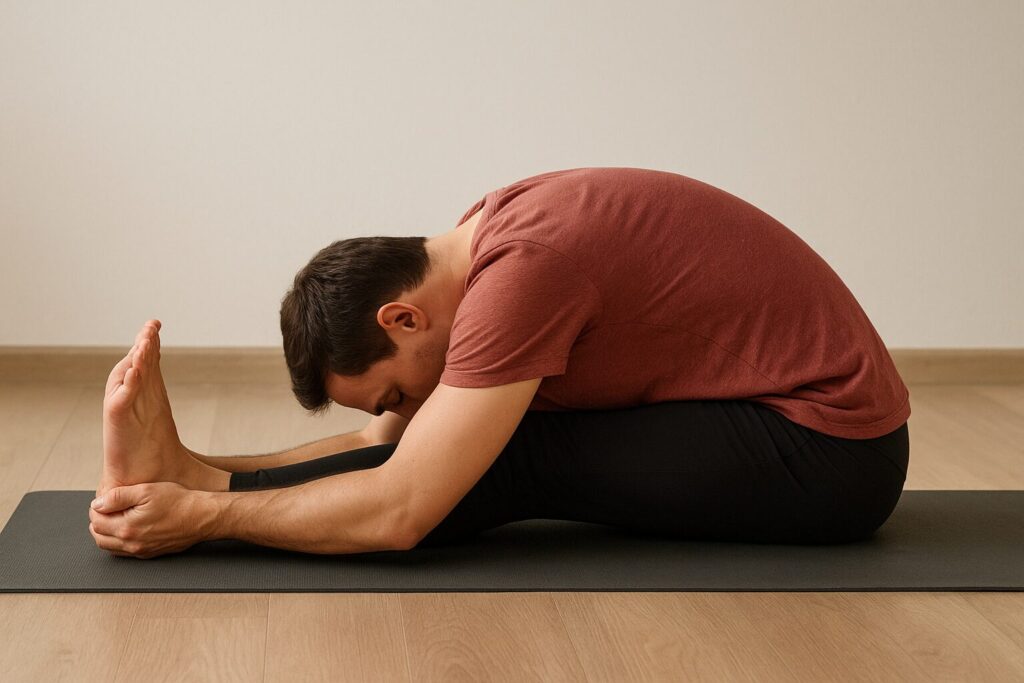
Generally, there are five groups of Mudras used in practicing Yoga:
Hasta Mudra (Hand Mudras):
- Gyana Mudra
- Chin Mudra
- Yoni Mudra
- Bhairava Mudra
- HridayaMudra
Mana Mudra (Head Mudras):
- Sambhavi Mudra
- Nasikagra Drishti
- Khechari Mudra
- Kaki Mudra
- Bhujangini Mudra
- Bhoochari Mudra
- Akashi Mudra
- Shanmukhi Mudra
- Unmani Mudra
Kaya Mudra (Postural Mudras):
- Prana Mudra
- Vipareeta Karani Mudra
- Yoga Mudra
- Pashinee Mudra
- Manduki Mudra
- Tadagi Mudra
Bandha (Lock Mudras):
- Maha Mudra
- Maha Bheda Mudra
Adhara (Perineal Mudras):
- Ashwini Mudra
- Vajroli Mudra
1. What is Maha Mudra, and a brief overview in Yogic Tradition:
Maha Mudra: Maha Mudra is a seated yogic posture where a practitioner extends one leg forward and the other leg is kept bent so that the heel can press the perineum, and the practitioner folds himself forward to hold the toe of the extended leg. In this position, the practitioner applies a specific breathing techniques and energetic locks which helps to direct the flow of Prana, the vital life energy through the energy channels (Nadis).
Sage Gheranda described Maha Mudra as:
Paayumoolam Vaamagulphe Sampeedya Dridayatnatah;
Yaamyapadaam Praasaaryaatha Karopaattapadaangulih.
Kantha Sankochanam Kritvaa Bhruvormadhyam Nireekashyet;
Poorkairvayayum Sampooryaa Mahamudraa Nigadyate.
Valitam Palitam Chaiva Jaraa Mrityum Nivaarayet;
Kashyakaasam Udaavartapleehaajeernajvaram Tathaa;
Naashayetsarvorogaamshcha Mamudraaprasaadhanaat.
The meaning of the above Sanskrit Sloka is:
How to practice Maha Mudra:
- Press the perineum firmly with the heel of the left foot.
- Stretch the right leg straight in front.
- Grasp the toes of the extended foot with both hands.
- Apply throat contraction (Jalandhara Bandha) and fix the gaze at the space between the eyebrows.
- Fill the body with prana through inhalation, then hold the breath with full awareness.
- This posture and process together are called Maha Mudra – the Great Seal.
Benefits of Maha Mudra:
Maha Mudra is said to destroy old age (Jaraa), Grey Hair, and even prevent untimely death (Mrityu).
It cures diseases like:
- Kāshya – disorders of the spleen and abdomen
- Kāsa – cough and respiratory troubles
- Udaavarta – digestive disorders from blocked wind
- Pleeha – spleen enlargement
- Ajeerna – indigestion
- Jvara – fever
- It is described that it removes all diseases and keeps the body healthy and the mind steady.
02. Why Maha Mudra is called The Great Gesture:
Maha Mudra is called the Great Gesture since it seals the vital energy, which combines the body-breath and mind practices and helps to awaken the spiritual power and overall well-being of the body.
i. Maha Mudra seals the energy flow: In Yoga, Mudra plays a vital role since it seals the energy. Maha Mudra is “Great Seal” because it combines three main energy locks:
- Mula Banda (Root Lock)
- Uddiyana Banda (Abdominal Lock), and
- Jalandhara Bandha (Throat Lock)
These together seal the energy to stop flowing outwardly; instead, it helps to flow inwardly through the Sushumna Nadi (Spinal Channel), and that’s why it is called “The Great Gesture”.
ii. Maha Mudra balances the Body, Mind, and Spirit:
Maha Mudra is not just a physical posture like an ordinary posture, but it integrates Asana, Pranayama, and Bandhas in one practice. This combined energy purifies the Nadis, strengthens the nervous system, and prepares the body for proper Meditation.
iii. Maha Mudra is a Gateway to a Higher State of Consciousness:
From our ancestral classical texts like Gheranda Samhita and Hatha Yoga Pradipika, we get “Maha Mudra can destroy diseases, delay aging, and awaken our dormant Spiritual Energy (Kundalini Shakti), and it helps the Yogis to reach liberation (Moksha). Since it is the most powerful practice that can transform ordinary awareness to higher consciousness, therefore, it is called a “Great Gesture”.
3. The Origin and Meaning of Maha Mudra:
The word Maha Mudra is deeply rooted in ancient Yogic tradition; the reference can be hand in Hatha Yoga texts, Tantras, and also we find its roots in Puranic wisdom. While all Puranas do not directly explain the details of practicing technique but later on, Sage Gheranda explained the technique. The concept of Maha Mudra and its spiritual origin can be traced back to Lord Shiva’s teachings to Goddess Parvati and the related stories amongst the Nath Yogis.
Puranic Connection: According to the Shiva Purana and the Skanda Purana, Lord Shiva is regarded as Adi Yogi/First Yogi and the first teacher of Yoga. From the above scriptures, we get that Lord Shiva imparts various techniques in Yoga practices, including Mudras and Bandhas. It is said that Lord Shiva revealed the secret technique of Maha Mudra to control Pranic energy (vital force) with Apana (downward energy) within the Shushumna Nadi (the central channel). By uniting Prana and Apana, a Yogi can overcome his old age, prevent diseases, and even conquer death.
In the Shiva Purana, there is a detailed description of how Prana, when it is controlled, can liberate a Yogi from the bondage of Time (Kala). In Yogic texts, Maha Mudra is often called the “Destroyer of Time” (Kala Vinashaka).
The Garuda Purana and Markandeya Purana lay emphasis on the importance of Breath Control (Pranayama) and Mudras for achieving liberation (Moksha), which aligns with the benefits of Maha Mudra.
Immortality and Sage Markendaya: From the Markendaya Purana, we know the story of Sage Markendaya, who conquered death by Lord Shiva’s blessings. Symbolically, Maha Mudra is connected with this idea, since the text says “Maha Mudra removes the effects of old age, diseases, and fear of death”. Therefore, the regular practice of Maha Mudra directly connects with the Puranic Promise of freedom from decay and mortality.
Meaning of Maha Mudra: In Sanskrit, the word Maha Mudra consists of two parts: Maha means “Great, Supreme, or ultimate” and Mudra means Gesture, Seal, or psychological attitude. So, the Maha Mudra means “The Great Seal” or “The Great Gesture”.
4. How to Perform Maha Mudra: Since Maha Mudra is a highly secret technique and is not permissible for any disciple of a Yoga Guru to divulge this secret, this cannot be disclosed as per his instruction. However, I have been discussing here only the theoretical part; the practical part will be disclosed by him only during initiation.
Maha Mudra stimulates the Shakti in the energy circuit from Mooladhara Chakra to Ajna Chakra, and its effects can be felt strongly on a psychic level. Physiologically, it can stimulate the digestive capacity, and psychologically, it can develop the mind and inner awareness and arouse receptivity.
Preparation before practice: Before starting Maha Mudra, it is important for the practitioner to prepare their body and mind so that the body is safe and effective and can achieve maximum benefit.
- Choose the Right Time: Before sunrise is the best time because there is no disturbance in and around, and, if not possible, then in the evening, but 3-4 hrs. after taking a meal. A calm, quiet, and airy environment is suitable for practice.
- Warm up the body: Some gentle Yoga Asanas like Paschimottanasana and Baddha Konasana can be practiced since these two postures reduce the stiffness of the body, loosen the hips, hamstrings, and spine for performing Maha Mudra more comfortably.
- Prepare Mind: Spend a few minutes in deep breathing or simple meditation to prepare your mind. A peaceful and calm mental state can enhance mental concentration while practicing Maha Mudra.
- Learn Bandhas: Practitioners should be familiar with Moola Bandha (Root Lock), Uddiyana Bandha (Abdominal Lock), and Jalandhara Banda (Throat Lock) because these Bandhas combine Maha Mudra.
- Medical Consideration: If the practitioners have back pain, high blood pressure, or any abdominal problems, he/she should consult a well-qualified Yoga Teacher or a Doctor before starting Maha Mudra.
Technique of performing Maha Mudra: Sit comfortably on a Yoga Mat, with outstretched legs. Bend the left knee and press the left heel firmly into the perineum, the point of Mooladhara Chakra. The right leg should be kept outstretched. Inhale deeply in this position, then exhale and bend forward to clasp the right toe firmly with both hands. Now slowly inhale, tilt the head backward, hold the breath inside, and perform Shambhavi Mudra and Moola Bandha. This is the initial stage of the practice. This position is held as long as Antar Kumbhaka (Internal Breathe retention) can be comfortably retained. Now, while releasing, place the palms on the knees and straighten the head and exhale.
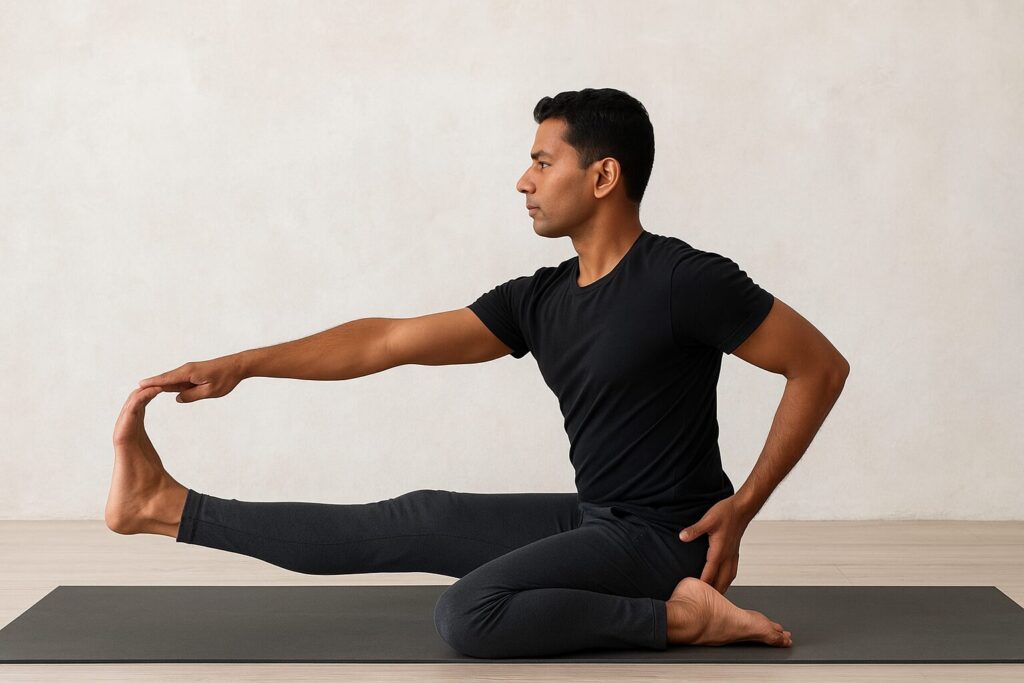
Now, reverse bend the right knee and press the right heel firmly into the perineum. The left leg should be outstretched. Inhale deeply in this position, then exhale and bend forward to clasp the left toe firmly with both hands. Now inhale slowly, tilt the head backward, hold the breath inside, and again perform Shambhavi Mudra and Moola Bandha. Now, slowly exhale and straighten your right leg.
In the last stage, both the legs are outstretched, inhale deeply, and bend forward to hold tightly both the toes and try to touch your forehead on the knees. Chant Om Mantra internally. Then release your hands from the toes and sit in Lotus Posture (Padmasana) and exhale.
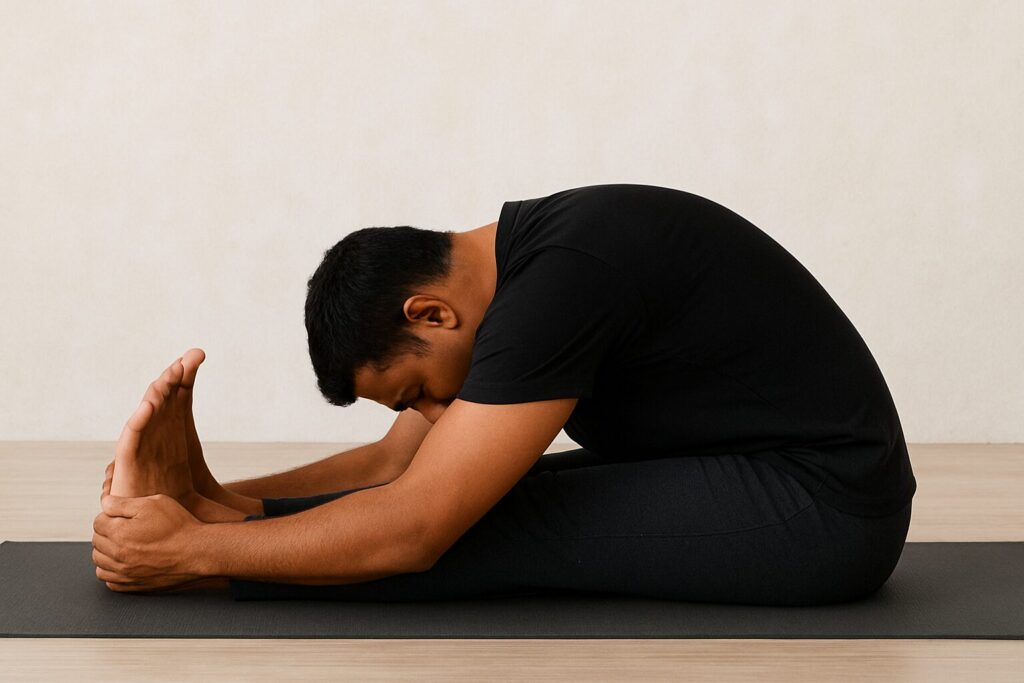
One round is equivalent to one complete inhalation and exhalation. It will be for the practitioners to be in Kumbhaka as long as possible, but not straining the lungs. The Kumbhaka can be extended over a period of continuous practice. It is preferable for the beginners to practice five to six rounds daily. This can be slowly increased to 12 rounds over a period of time. Later on, this will be added with KHECHARI MUDRA for higher spiritual achievement. Here, Lotus Pose is very useful.
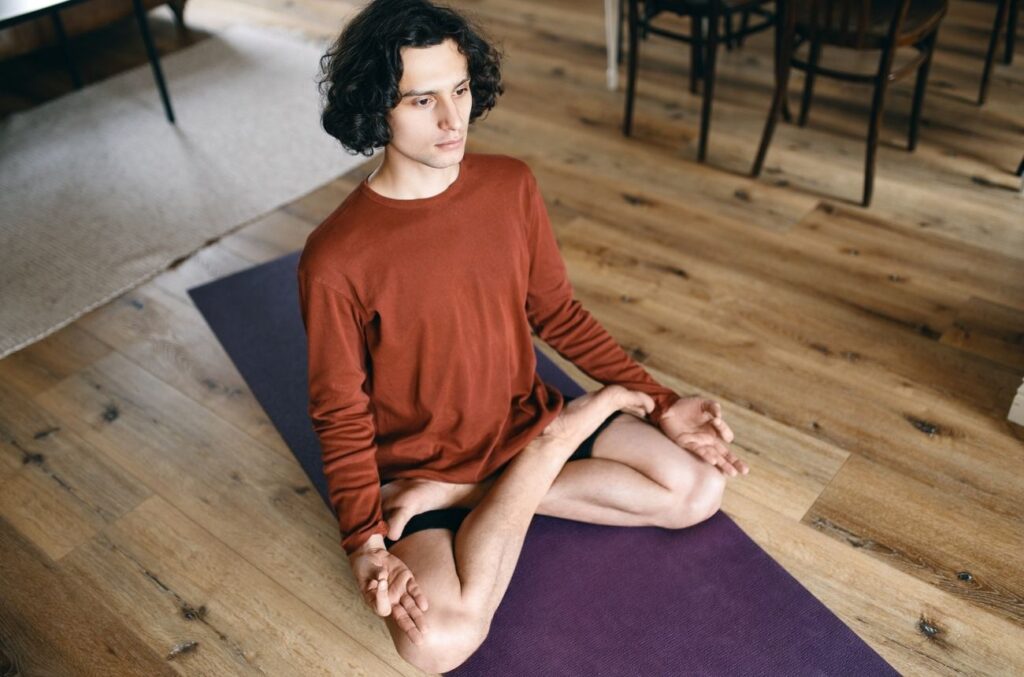
I have gone through various books, but none of them explained in detail, as I have explained above. Only the Kriya Yogis who are performing can describe. Therefore, I request that my readers please not discuss with others.
5. Precautions while performing Maha Mudra: People suffering from High Blood Pressure, Heart complaints, or glaucoma should not perform this practice, of course, without the guidance of an enlightened Yoga guru. Maha Mudra should not be practiced without prior purification of the body. Impurity within the body is indicated by the symptoms of accumulated toxins, which create itching and skin eruptions.
Since it generates a huge amount of heat within the body, the number of rounds should be reduced during Summer, and thereafter it can be increased in the Winter. Women should avoid practicing during Menstruation and Pregnancy because it has a strong effect on the abdomen and pelvic region. Last but not least, the practitioner should listen to their body. Never try to push beyond the control level. Mild stretching is beneficial, but forceful practice can lead to injury.
6. Benefits of Practicing Maha Mudra:
i.Physical Benefit: Maha Mudra is not only a spiritual practice but also a unique healing technique of the body. Regular practice of Maha Mudra extends several physical benefits that support overall health and vitality.
- Improves Digestion: Digestion is improved, and related diseases to the stomach are reduced. With the continuous practice of Maha Mudra, disorders like excess Kapha, Piles, Tuberculosis, ailments of the Spleen and Throat, Fever, etc., which are linked with the Digestive system, show improvement.
- Strengthen Nervous System: The combination of Postures, Breath Control (Pranayama), and the Bandhas strengthens the nervous system. The sympathetic and parasympathetic nervous systems are balanced. Peace and tranquility are established in the sensory and motor nerves connecting the senses, body, and mind. Sensory experiences are reduced and thereby reducing excitement and calming the activity in the brain.
- Enhances Flexibility: The forward bend stretches the hamstrings, hips, and spine, reducing stiffness and improving the mobility in the lower back and legs.
- Boosts Circulation: Kumbhaka (Breath retention) and energy locks help to increase the blood flow to the vital organs within the body, nourishing the heart muscles, promoting hormonal balance, and better metabolism.
ii. Mental and Emotional Benefits: Maha Mudra is generally revered for physical fitness. Apart from this, it calms the mind and balances the emotions. With consistent practice, the practitioners can experience:
- Reduced stress and Anxiety
- Sharpens the concentration
- Balanced emotional energy
- Enhanced Inner Awareness
- Improved Emotional Resilience and inner peace
iii. Energetic Benefits of Practicing Maha Mudra: Apart from Physical, Mental, and Emotional benefits, Maha Mudra is revered as a Master practice of Prana – the vital force which flows through the body’s energy channel (Nadis). Various Yogic texts like Gheranda Samhita and Shiva Purana highlight its power to regulate, conserve, and elevate the subtle energy:
- Prana Control (Vital Energy Management): Maha Mudra combines the three Bandhas (Jalandhara Bandha, Uddiyana Bandha and Mula Bandha). These three locks (Bandhas) seal the energy and prevent its outward dissipation and push upward through the spine. This controlled flow of upward energy enhances vitality, inner strength, and stamina.
- Purification of Energy Channels (Nadis): Most of the Yogis call Maha Mudra as Bhoota Shuddhi (here Bhoota means Body). According to the Yogis, Prana (this vital force) flows through the Nadis (Energy Channels). When these channels are blocked, the created energy stagnates and creates physical and emotional imbalance.
- Awakening of Kundalini Shakti (Kundalini Energy): By channelizing this Energy (Prana) upward, Maha Mudra prepares the Yogis for attaining a higher state of spiritual consciousness.
- Strengthen the Subtle Body: By consistent practice of Maha Mudra, the energized body (Pranamaya Kosha) becomes stronger, which supports vitality and spiritual growth.
In a nutshell, Maha Mudra is called “The Great Seal” because it locks Prana within, purifies the Nadis (energy channels), and channelize this energy upward for attaining a higher consciousness.
7. How Maha Mudra differs from Hatha Yoga, Tantra, and Tibetan tradition:
Comparison of Maha Mudra in different Traditions:
| Tradition | Nature of Practice | Main Focus | Techniques | Goal |
| Hatha Yoga | Physical and Energetic Practice | Body, Breath Control, and Prana | Seated Posture, Forward Bend, Bandhas, and Pranayama | Purification of Channels, Preservation of vitality, preparation for Meditation. |
| Tantra | Energetic Spiritual Practice | Union of Shiva and Shakti | Mudras, Mantras, Rituals and Subtle Energy work | Kundalini Awakening, Merging awareness with higher energy |
| Tibetan/ Buddhism | Meditative/Philosophical practice | Mind and Ultimate Reality | Deep Meditation, Mindfulness, Insight Practices | Realization of the true nature of the mind, liberation from duality. |
8. How to combine Maha Mudra with various Yoga Practices:
Maha Mudra is generally described as a Master Practice in the course of Yoga practices. It combines with other yoga techniques for getting maximum results. When it is practiced mindfully, it creates a bridge between other physical postures, pranayama (breathing exercise), and Dhyana (Meditation).
A flow chart of Maha Mudra practice is given hereunder:
- Warm-up: For (5-10) minutes – Gentle stretches =>Surya Namaskar (2-3 rounds) => Preparatory Poses like Paschimottanasana (Seated Forward Bend) and Ardha Matsyendrasana (Half Spinal twist).
- Pranayama: (5-10 minutes): Nadi Sodhana (Alternate Nostril Breathing) => Kapalbhati => Slow deep breathing.
- Maha Mudra Practice (10-15 minutes): Sit in Maha Mudra Posture => Start Bandhas => Hold steady breath (Kumbhaka) => focus between eyebrows (Kutastha).
- Meditation: (10-15 minutes) – Sit in Lotus Pose => Chant Om Mantra within => Rest in stillness with proper attention.
- Closing: (2-3 minutes): Relax in Shavasana => Express gratitude to Almighty God => Return to regular work.
Warm-up & Asanas → Pranayama → Maha Mudra → Meditation → Closing Relaxation
9. Beginners’ Guide to Start Maha Mudra:
- Start with a short session
- Start Warm-Up Asanas
- Gradually integrate into daily practice
10. Conclusion: Embrace Maha Mudra in your Yoga Journey:
Maha Mudra is more than just a Yoga technique. It is a practice for your whole life, which will help you to preserve your energy, cleanse your system, and connect you with your higher self. Every time you sit for this revered practice, you are stepping closer to harmony, strength, and inner freedom.
Maha Mudra removes all the worst afflictions and the cause of death. Therefore, it is called a “Great Gesture/Great Attitude” by those of the highest knowledge. One who practices Maha Mudra regularly, there is wholesome or unwholesome. “Anything can be consumed, even the deadliest poison can be digested like Nectar”.
Therefore, just don’t read about it – but experience its benefits. Spare a few minutes of your valuable time, combine it with simple Asanas and Pranayama, and you will see that Maha Mudra will guide you towards Physical Balance, Mental Clarity, and Higher Spiritual attainment.
FAQ:
- What is the difference between Maha Mudra and Mah Mudra?
Ans: Many people get confused between Mah Mudra and Maha Mudra. The main difference is :
Maha Mudra – Maha Mudra is a Hatha Yoga tradition. It means (Maha means Great and Mudra means Gesture, therefore, combining these two, it is a Great Gesture/Attitude). It has been described in Hatha Yoga Pradipika, Gheranda Samhita, and Shiva Samhita. The practice combines Seated Pose, Pranayama, and Bandhas.
Mah Mudra – Mah Mudra is used in Tantric and Tibetan Buddhist traditions. Meaning is the same as Maha Mudra. But its practice does not refer to Yogic Posture, it refers to a state of meditation and self-realization where the practitioner recognizes the nature of mind, emptiness, and awareness.
- Can beginners practice safely?
Ans: Yes, it is safe for beginners, but with the proper guidance of a qualified Yoga Teacher. Maha Mudra is described as the most powerful Yoga Practice in Hatha Yoga, but it does not mean this can be practiced by advanced practitioners. This can be practiced by beginners in a simplified form by focusing on posture, gentle breathing and mindfulness.
- How long should I practice Maha Mudra?
Ans: For the beginners, Maha Mudra can be practiced for 10-15 minutes. Initially, the practitioners should start with 20-30 seconds of breathing. Breath retention (Kumbhaka) can be continued for 5-10 seconds. Focus should be on Asana (Posture), gentle breath, and awareness rather than long holding.
For Intermediate practitioners, they should continue 30-60 seconds per side. Breath retention (Kumbhaka) should be enhanced for 30-45 seconds, depending on comfort level. Repeat 3-5 times on each leg.
For Advanced practitioners, Maha Mudra can be practiced 3-5 minutes per side with longer retention time. For advanced practitioners, Bandhas can be used with longer Kumbhaka for deeper Pranic control.
- Does Maha Mudra help in Kundalini Awakening?
Ans: Yes, Maha Mudra regulates the flow of Pranic energy in the body by activating and harmonizing the three channels (Ida, Pingala, and Shushumna. This activation of the channels prepares the pathway for Kundalini to gradually rise upward.
- Can Maha Mudra be practiced without a Yoga Teacher?
Ans: Yes. At the beginning, this can be practiced without a Yoga Teacher, but the practitioner should have some theoretical knowledge prior to practicing. The beginners can practice the physical posture like the seated position, leg bending and stretching, forward bend, and gentle breathing. These simple practices help with flexibility, digestion, and calming down the mind. But, in the case of practicing Bandhas, the practitioners should get help from a qualified Yoga Teacher, and if they want to explore Kundalini-related benefits.


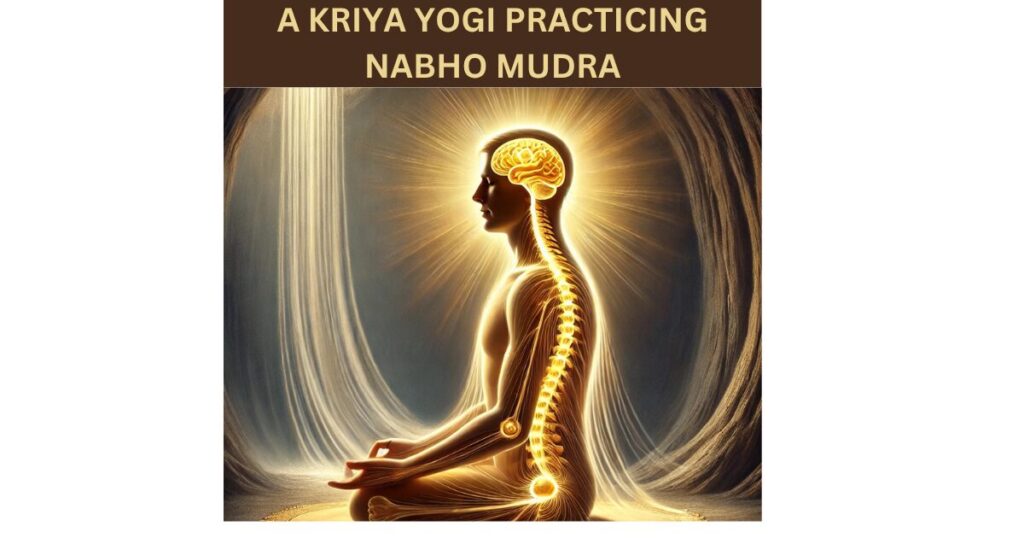


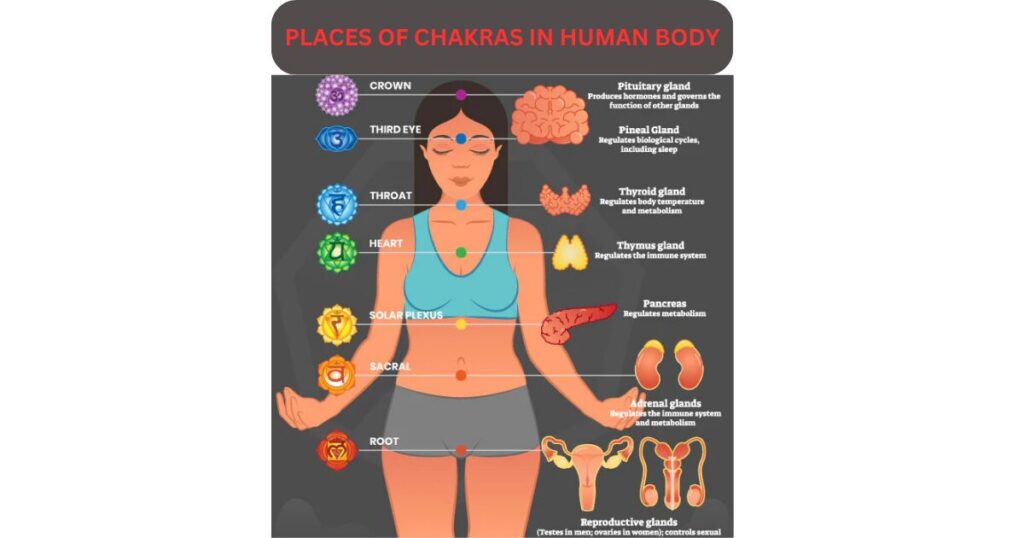
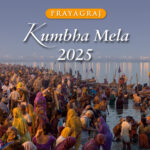
3 thoughts on “MAHA MUDRA – FROM TRADITION TO TRANSFORMATION”